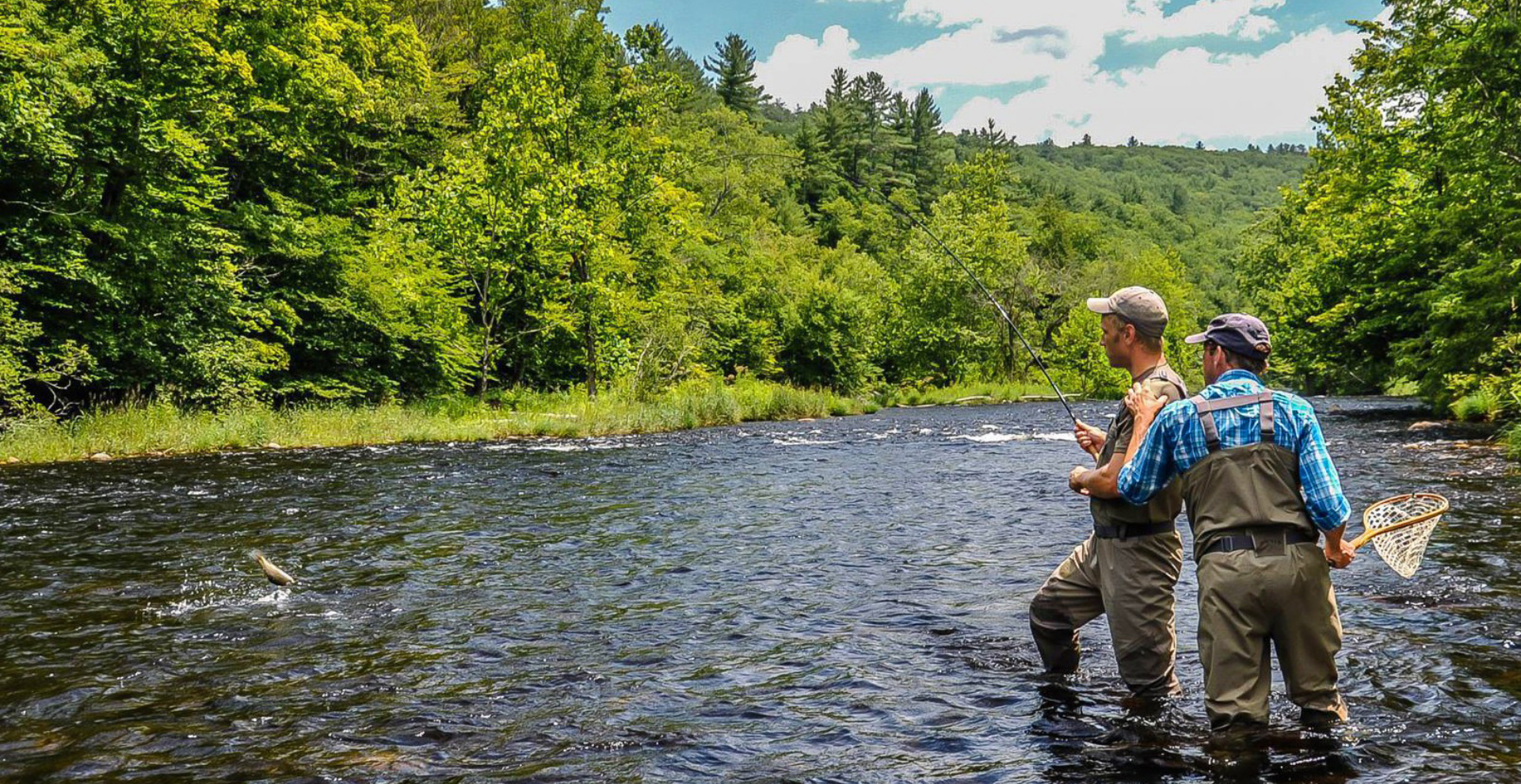

Those who shared the river when Dennice Tafolla caught her first fish say its size rivaled that of a sardine. Tafolla swears that it looked like something snatched from a Herman Melville novel. Size aside, “that little guy was a fighter,” Tafolla says. But unlike Captain Ahab, what plagued Tafolla was not the fish — it was the post-traumatic stress disorder she developed after eight years in the U.S. Army. And that “little guy” served as a key part of her recovery.
Tafolla enlisted in the army on June 6, 2006 (or “6-6-6,” as she likes to point out, and a detail that made her friends ask if that was a bad omen). She served eight years as a member of the military police. But her return to civilian life required multiple medications to treat her anxiety and post traumatic stress disorder (PTSD). Fellow veterans believed there might be something other than pills to help her overcome those mental-health challenges and approached her at the Veterans Affairs Center in Modesto, Calif., with the idea that she participate in an outdoor recovery program. But she was hesitant to believe them when they told her a fishing trip might help her with her PTSD. It felt like a scam to Tafolla. “Sign here, and someone will call you,” they told her.
What she signed up for was a four-day fly-fishing trip with six other veterans. However, it wasn’t a scam. Science supports the idea that outdoor experiences help mitigate PTSD and anxiety. A river-rafting study in 2018 conducted by psychologists from the University of California at Berkeley and in partnership with the Sierra Club’s Great Outdoors Lab found that the 52 at-risk, inner-city youth and 72 military vets who participated in white-water rafting trips reported significant improvements in well-being. In fact, the participants reported a 29% reduction in PTSD, 21% decrease in stress, a 10% improvement in social relationships, a 9% improvement in life satisfaction, and an 8% boost in happiness.
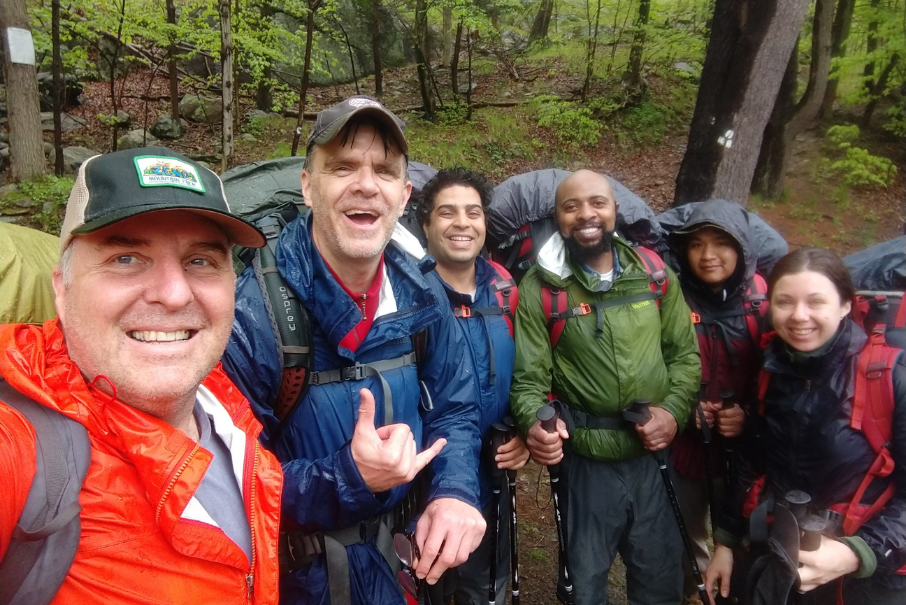
“We’re doing this to help veterans learn how they can lead a healthy and purposeful civilian life, knowing that if they are leading that healthy and purposeful civilian life, then they’re less susceptible to suicidal ideations,” says Aaron Leonard (far left), a campaign representative with Sierra Club’s Military Outdoors program. Photo courtesy of Rivers of Recovery/Aaron Leonard.
Dan Laffin, board director of Rivers of Recovery, an organization that specializes in the rehabilitation of combat veterans suffering from PTSD, minor traumatic brain injury, stress, anxiety, and depression, sees that science in action often on the four-day fly-fishing trips his organization offers. He says fly-fishing is a difficult task that requires participants to work on to improve — much like being a soldier. When you surround veterans with other veterans, he says, they create a bond naturally, because they are the only ones who can understand one another. “It kind of brings veterans back together and gives them a common thing to do together,” Laffin says. “A lot of them become best friends.”
Rivers of Recovery is not the only program that focuses on rehabilitating veterans with PTSD through fly-fishing. Warriors and Quiet Waters was created for post 9/11 veterans in 2007 and has given 920 fishing experiences to combat veterans and their spouses from all over the country. Project Healing Waters Fly Fishing, Inc. started in ‘05 with the same mission, but focused on disabled veterans and active military personnel. In 2019, a total of 8,593 participants were able to experience the program at no cost with the help of volunteers.
The success of these programs prompted politicians to propose legislation to support veterans suffering from the mental challenges created by their service through these opportunities. In 2019 Chris Smith, representative of New Jersey, and Adam Smith, representative of Washington D.C., reintroduced the Accelerating Veterans Recovery Outdoors Act. The bipartisan legislation signaled these programs delivered more than just alternatives to treating PTSD. “Veterans have demanded for years outdoor recreation programs be a part of our health treatment,” says Robert White, vice president of Internal Relations for Minority Veterans of America. “It is long overdue for the VA to recognize this basic, yet vital need.”
With the passing of the Veterans' Compact Act of 2020 [H.R.8247], a bill that adds support for the Department of Veterans Affairs, more support comes to veterans using public lands or other outdoor spaces to recover from their time in the military. Dr. Keith G. Tidball, senior extension associate in the Department of Natural Resources at Cornell University, says that the passing of bills such as H.R.8247 and the Outdoor Rx Act [SB S6706A], which passed in New York state, serves as evidence the medical community has embraced nature-based outdoor education as a treatment for veterans and active duty members.
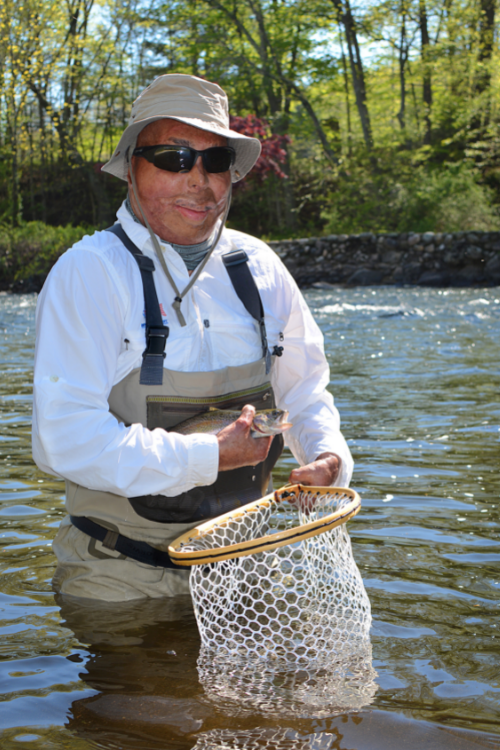
In Iraq, a rocket struck Jose Jauregui’s howitzer, killing three of the four-man crew. The sole survivor, he suffered burns over 75% of his body. After his first Rivers of Recovery trip, he volunteered on others and now works as the director of guiding operations. Photo courtesy of Rivers of Recovery/Aaron Leonard.
There are three categories — war and combat, violence and abuse, and disaster and terrorism — typically serve as catalysts for PTSD. For military service members, exposure to combat can be attributed to PTSD and other mental health problems, whether it be at risk of death or injury, seeing their comrades hurt or killed, or having to kill or wound others.
Operation Iraqi Freedom and Enduring Freedom found that about 11-20% veterans who served suffer from PTSD in a given year, about 12% who served in Desert Storm have PTSD in a given year, and about 15% of Vietnam veterans were currently diagnosed with PTSD at the time of the most recent study in the late 1980s, the National Vietnam Veterans Readjustment Study (NVVRS),it is estimated that about 30% of Vietnam veterans suffered from PTSD in their lifetime.
Currently, H.R.8247 and SB S6706A do not allow veterans and active duty members to be prescribed programs like Rivers of Recovery — but it’s a start. Aaron Leonard, campaign representative with Sierra Club’s Military Outdoor program, refers to both bills as “study bills”. Both bills have the same mandates, which is to create a task force to give recommendations on public lands and outdoor spaces.
Both bills come at a time when the state of veterans’ mental health earns a great deal of attention. A report for Brown University’s Cost of War Project offered this statistic: An estimated 7,057 service members have died during military operations since 9/11; yet, suicides among active duty personnel and veterans of those conflicts have reached a number more than four times that — 30,177. Other research documents this crisis. In a report by the VA last year, it was shown that the number of Veteran suicides per day was 17.6 in 2018, which is over 6,400 that year. The report also showed that the rate of suicide among veterans who recieved recent VA care decreased by 2.4%. Leonard, who has 27 years in the U.S. Army, believes there would be a greater reduction in suicides among veterans and would occur through greater exposure to structured programs in the natural world.
“We’re doing this to help veterans learn how they can lead a healthy and purposeful civilian life, knowing that if they are leading that healthy and purposeful civilian life, then they’re less susceptible to suicidal ideations,” Leonard says.
But despite the recent attention around the power of nature to health a mind, the idea of fly-fishing after going off to war isn’t a new concept. In feudal Japan, there were two schools of traditional fly-fishing: Tenkara and Dobu. Tenkara was practiced by mountain-dwelling woodsmen, and Dobu was practiced by the Samurai, who, given their status, were some of the only people allowed on streams and rivers. Evidence of taking off into nature after war exists in the U.S. too. In 1948, a WWII veteran by the name of Earl Schaffer completed a thru-hike of the Appalachian Trail to “walk the war out of [his] system.”
That purpose reverberates in today’s programs. Founded by Dan T. Cook, a former Wall Street energy trader, in 2008, Rivers of Recovery’s sole mission is to rehabilitate veterans and active duty members suffering from post-traumatic stress disorder through fly-fishing. But Outward Bound offered the first outdoor education program for veterans in the 1980s. The history of Outward Bound starts in 1939, with a man by the name of Kurt Hahn. When a friend suggested to Hahn that the reason for unnecessary deaths in the Battle of the Atlantic was due to lack of training, he proposed a school for British youth that would include a month-long course focusing on physical fitness, enterprise, and tenacity. Today’s version of that course seeks to provide veterans with a sense of normalcy, a bridge for veterans to re-enter society.
Leonard says he once participated in a week-long dog-sledding trip in 2012 with the program while he was still on active duty. He says he remembers mornings waking up to sub-zero temperatures with just a sleeping bag. “The first thing we needed to learn how to do was to stay warm,” Leonard says. “How to get out of the sleeping bag in extreme cold. You can’t just get out. If you just jump out, you will get frostbite pretty quick.” Leonard says Outward Bound taught him and others resilience building, a big component of the army and a form of “positive psychology,” a scientific approach focusing on positive events in a person’s life.
“I sort of had this rebirth of my own confidence,” Tidball says.
For Leonard, that dog-sledding altered his life’s trajectory in other ways. Leonard met his predecessor, Stacy Bare, who would later inspire Didi Barret, a New York state assembly member, to create SB S6706A. The trip also led Leonard to rethink his life’s mission and to dedicate himself to helping veterans and active duty members recover. But how he would do that didn’t occur to him until a year later when Leonard found himself underneath the West Texas night sky, and he decided he would retire from the Army to pursue a career in wilderness therapy.
“I had just been promoted to lieutenant colonel, and I had a promising career still ahead of me,” Leonard says in an episode of “Stories from the Field,” a podcast dedicated to demystifying wilderness therapy. “If I had not done that, I’d more likely still be in the military today.”
Leonard sits on the board of the Outdoor Rx task force with Tidball, where they currently survey public green spaces in the state of New York to see if they are accessible to veterans with disabilities. Leonard and Tidball share something in common in that both were led to wilderness therapy. Tidball would have also been in the military today if it hadn’t been for a head and eye injury he sustained in the ‘90s during his time as a member of the New York Guard. On September 10, 2001, Tidball was scheduled to have his final surgery to correct his vision. The next day he received a call from his doctor saying the surgery was unsuccessful. Shortly after the phone call, the first plane hit one of the Twin Towers.
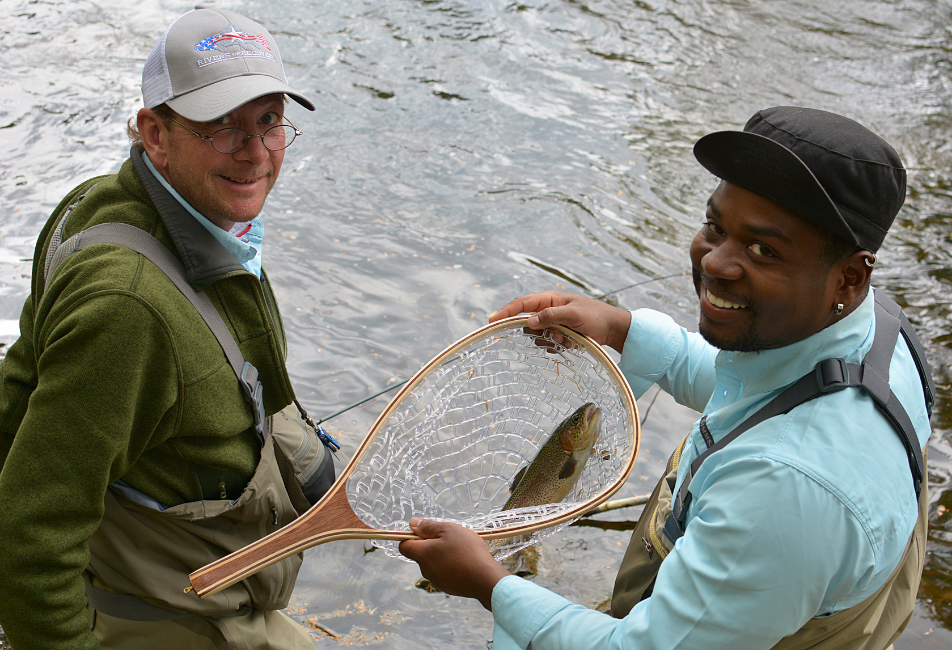
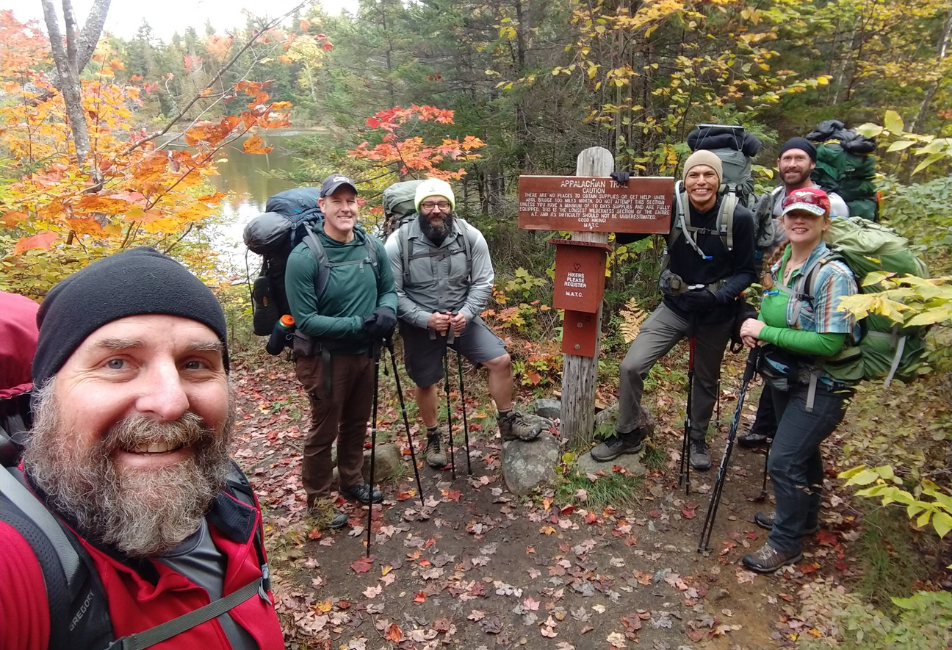
“I think there’s a huge therapeutic value in getting together with people and going out on these trips,” says Dan Laffin, board director of Rivers of Recovery. “And just the ability to get together with someone, to hug them, to hold a fly rod with them, to teach them how to cast.” Photo courtesy of Rivers of Recovery/Aaron Leonard.
After that, Tidball admits he began to experience “survivor’s guilt.” While America prepared for a war that would take more than 6,000 U.S. service members' lives, he was told that he would have to sit out for what he describes as the “fight of a generation.”. Then, he watched as his friends, people who worked under him, deployed to Iraq and Afghanistan. Some didn’t come back, some came back not the way they would have wanted, he says.
But a hunting trip in Maine helped Tidball reclaim his peace of mind. When he first shot at a covey of grouse, he admits his aim was off, another reminder of what he’d lost. Then, his friend began to encourage him, and his aim improved. “I sort of had this rebirth of my own confidence,” Tidball says. “I thought I could actually get back out and do things I might enjoy.”
Both Tidball and Leonard identify funding as one of the main issues facing outdoor education programs. “If this stuff is just ‘nice-to-do’s’ and organizations have to raise money to host events, to take veterans into the wilderness to do things, then the limitation is money and access,” Tidball says. “But, if these things are prescribed by your medical doctor at the VA or elsewhere, then your insurance pays for the activity because it’s a prescription — then the money problem is gone.”
Some programs have suffered from funding during the pandemic and see the passing of the H.R.8247 and SB S6706A as a positive step toward financial stability. Outward Bound, which has won grants in the past and is revered by people such as Leonard, is one of these programs. But Peter Steinhauser, Outward Bound executive director, says he feels that the U.S. government could do more. “There just seems to be this unfortunate gap between, on one hand, programs that are demonstrated to have a significant positive impact on participants — then on the other side of this gap, the funding made available,” Steinhauser says.
Other barriers lie within the female veteran community. As of 2015, women comprised 15% of the military population (the last year the administration provided numbers), with an annual growth of 1% — a total of more than two million female veterans. This population typically faces different, additional challenges. For example, they are more likely to experience military sexual trauma, which increases PTSD risk as much as, or more than, combat exposure. In the Department of Defense’s 2020 Annual Report on Sexual Assault in the Military, more than 6% of female service members on active duty reported experiencing sexual assault while men reported 0.7%. In 2020, 6,290 service members reported sexual assault incidents during military service, which is 54 more than 2019.
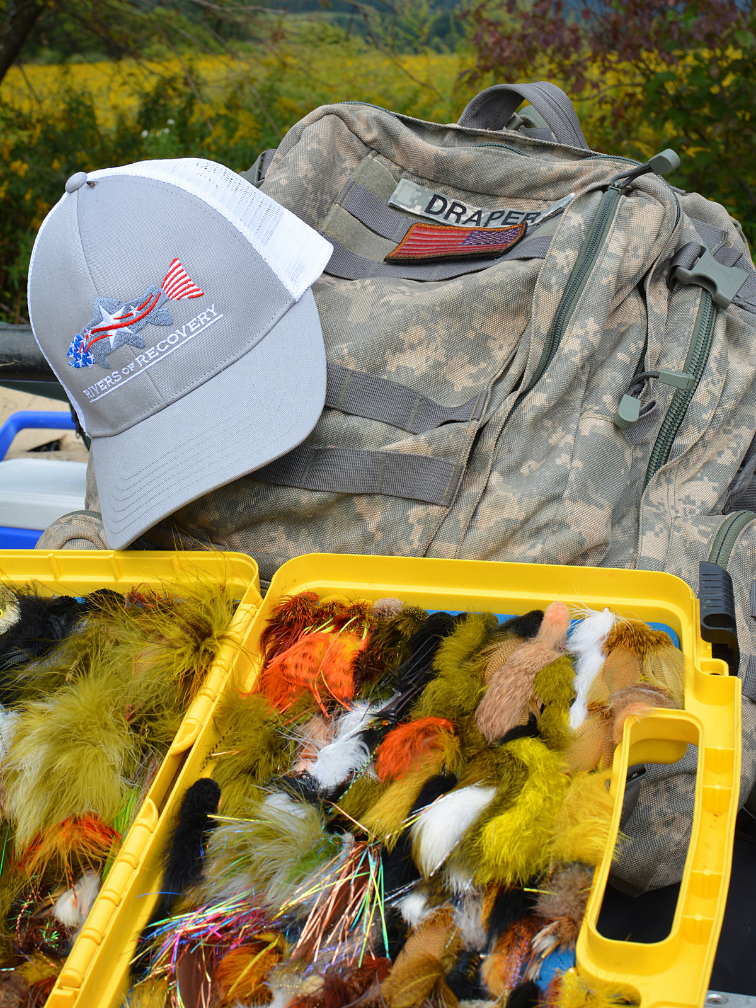
“Veterans have demanded for years outdoor recreation programs be a part of our health treatment,” says Robert White, vice president of Internal Relations for Minority Veterans of America. “It is long overdue for the VA to recognize this basic, yet vital need.” Photo courtesy Rivers of Recovery/Aaron Leonard.
Much like those suffering from PTSD, nature provides sexual assault survivors with similar benefits. For example, for those who associate the assault with emotions such as fear and powerlessness, outdoor experiences can help them begin to reframe those emotions with a sense of personal self efficacy and self-respect. To assist this population, some organizations such as the Sierra Club Military Outdoors Female Veterans offer women-vet-only programs. On her 2012 Rivers of Recovery trip, Tafolla remembers the only other female veteran with her and how she would “come and go” in terms of her comfort level. “I think she was having a hard time adjusting with us,” Tafolla says. “I remember all of us giving her time and space because she was just kind of a little bit more nervous to be around us.”
Tafolla later joined an all-female Rivers of Recovery trip.“I thought that was probably one of the best times,” Tafolla says. “Because you don’t get to see a whole lot of female veterans. I almost feel like they’re very rare.”
But during the Covid-19 pandemic, green spaces attracted a lot more visitors, and that too presented challenges for these programs. Tidball says there’s traffic jams anywhere in the high peaks pretty much all year long now. Plus, Zoom replaced human interaction, making the time around the campfire even more valuable. In fact, Tidball has an expression for this — “the campfire effect” — and says it typically happens on the last day of a trip when everyone gathers around the campfire and reflects. “You can’t find some sort of analogue for that campfire,” Tidball says. “Or that smell of the ocean, the smell of the lake, or the smell of the pines. Those aromas are actually shown to be therapeutic.”
Laffin says he has missed things as small as being able to give someone a high-five. “I think there’s a huge therapeutic value in getting together with people and going out on these trips,” he says. “And just the ability to get together with someone, to hug them, to hold a fly rod with them, to teach them how to cast. The disconnect now with everything virtual, I think, is pretty detrimental to the mental health of our veterans and everybody in general.”
In person, participants experience connection quickly. Amy Simon, Rivers of Recovery executive director, says it’s common for people to join the program and immediately connect within four days. Tafolla echoes that sentiment. Although she was the only female on her 2012 Rivers of Recovery trip, she felt welcomed immediately. On the second night at the dinner table, someone suggested they get ice cream. And although it was just a trip with new friends to get some frozen treats, the moment held significance for Tafolla — for the first time, she remembers thinking, she wasn’t alone. And for the first time, she wasn’t thinking about that whale of stress that hunted her.

Our pursuit of outdoor joy is remiss without the acknowledgement of the occupation of unceded Indigenous land. We are students and journalists working, writing, and living on the land of the Haudenosaunee Confederacy, comprising the Six Nations made up of the Mohawk, Onondaga, Oneida, Cayuga, Seneca, and Tuscarora nations. However, acknowledgement is not enough. Read More.